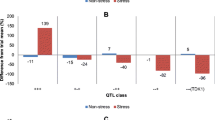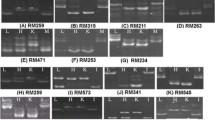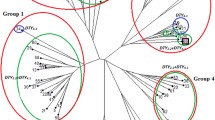Abstract
The genetic basis of high grain yield under reproductive-stage drought was studied using an F3-derived population generated from the cross of upland rice (Oryza sativa L.) cultivars Vandana and Way Rarem. Contributed by the susceptible parent Way Rarem, locus qDTY 12.1 was hypothesized to have interaction with loci from the Vandana genome to enhance the grain yield of tolerant line Vandana under drought. A test of the digenic interaction of qDTY 12.1 showed that two loci, qDTY 2.3 on chromosome 2 and qDTY 3.2 on chromosome 3, significantly increased the yield and harvest index of qDTY 12.1 -positive lines under severe upland and lowland drought conditions. qDTY 2.3 and qDTY 3.2 , in interaction with qDTY 12.1 , reduced days to flowering and plant height of qDTY 12.1 -positive lines under stress and non-stress conditions in upland. BC2F3-derived backcross inbred lines (BILs) were used to validate these results and identify new quantitative trait loci. Lines with qDTY 2.3 and qDTY 12.1 showed increased yield over Way Rarem under severe and moderate stress conditions, in upland. IR84996-50-4-B-4, a selection from one of the BILs, yielded more than the popular drought-tolerant cultivars Apo, UPLRi7, and IR74371-54-1-1 under severe stress conditions. Introgressed segments from Vandana also improved yield under non-stress conditions. The results indicate that digenic interactions can explain the genetic control of complex quantitative traits such as grain yield under drought, and a few interacting loci with large effects on grain yield or yield-related traits may enhance drought response across a wide range of genetic backgrounds and environments when introgressed together.


Similar content being viewed by others
References
Berloo RV (2008) GGT 2.0: versatile software for visualization and analysis of genetic data. J Hered 99(2):232–236
Bernier J, Kumar A, Venuprasad R, Spaner D, Atlin G (2007) A large-effect QTL for grain yield under reproductive-stage drought stress in upland rice. Crop Sci 47:507–516
Bernier J, Serraj R, Kumar A, Venuprasad R, Impa S, Gowda RPV, Oane R, Spaner D, Atlin G (2009a) The large-effect drought-resistance QTL12.1 increases water uptake in upland rice. Field Crops Res 110:139–146
Bernier J, Kumar A, Venuprasad R, Spaner D, Verulkar S, Mandal NP, Sinha PK, Peeraju P, Dongre PR, Mahto RN, Atlin G (2009b) Characterization of the effect of a QTL for drought resistance in rice, qtl12.1, over a range of environments in the Philippines and eastern India. Euphytica 166:207–217
Cockerham CC, Zeng ZB (1996) Design III with marker loci. Genetics 143:1437–1456
Dixit S, Swamy BPM, Vikram P, Ahmed HU, Sta Cruz MT, Amante M, Atri D, Leung H, Kumar A (2012) Fine mapping of QTLs for rice grain yield under drought reveals sub-QTLs conferring a response to variable drought severities. Theor Appl Genet. doi:10.1007/s00122-012-1823-9
Fijneman RJ, de Vries SS, Jansen RC, Demant P (1996) Complex interactions of new quantitative trait loci, Sluc1, Sluc2, Sluc3 and Sluc4, that influence the susceptibility to lung cancer in mouse. Nat Genet 14:465–467
Gurganus MC, Nuzhdin SV, Leips JW, Macky TFC (1999) High resolution mapping of quantitative triat loci for sternopleural bristle number in Drosophila melanogestar. Genetics 152:1585–1604
IRGSP (2005) The map-based sequence of the rice genome. Nature 436:793–800
Kosambi DD (1944) The estimation of map distances from recombination values. Ann Eugen 12:172–175
Kumar R, Venuprasad R, Atlin GN (2007) Genetic analysis of rainfed lowland rice drought tolerance under naturally-occurring stress in eastern India: heritability and QTL effects. Field Crops Res 103:42–52
Kumar A, Bernier J, Verulkar S, Lafitte HR, Atlin GN (2008) Breeding for drought tolerance: direct selection for yield, response to selection and use of drought-tolerant donors in upland and lowland-adapted populations. Field Crops Res 107:221–231
Lafitte HR, Price AH, Courtois B (2004) Yield response to water deficit in an upland rice mapping population: associations among traits and genetic markers. Theor Appl Genet 109:1237–1246
Lark KG, Chase K, Adler F, Mansur LM, Orf JH (1995) Interactions between quantitative trait loci in soybean in which trait variation at one locus is conditional upon a specific allele at another. Proc Natl Acad Sci USA 92:4656–4660
Li Z, Pinson SRM, Park WD, Paterson AH, Stansel JW (1997) Epistasis for three grain yield components in rice (Oryza sativa L.). Genetics 145:453–465
Li Z, Luo LJ, Mei HW, Wang DL, Shu QY, Tabien R, Zhong DB, Ying CS, Stansel JW, Khush GS, Paterson AH (2001) Overdominant epistatic loci are the primary genetic basis of inbreeding depression and heterosis in rice. I. Biomass and grain yield. Genetics 158:1737–1753
Liao CY, Wu P, Hu B, Yi KK (2001) Effects of genetic background and environment on QTLs and epistasis for rice (Oryza sativa L.) panicle number. Theor Appl Genet 103:104–111
Lukens LN, Doebley J (1999) Epistatic and environmental interactions for quantitative trait loci involved in maize evolution. Genet Res 74:291–302
Mackay TF (2001) The genetic architecture of quantitative traits. Annu Rev Genet 35:303–309
Paterson AH, Damon S, Hewitt JD, Zamir D, Rabinowitch HD, Lincoln SE, Lander ES, Tanksley SD (1991) Mendelian factors underlying quantitative traits in tomato: comparison across species, generations and environments. Genetics 127:181–197
SAS Institute Inc (2004) SAS online doc® 9.1.3. SAS Institute Inc., Cary, NC, USA
Venuprasad R, Lafitte HR, Atlin G (2007) Response to direct selection for grain yield under drought stress in rice. Crop Sci 47:285–293
Venuprasad R, Sta Cruz MT, Amante M, Magbanua R, Kumar A, Atlin G (2008) Response to two cycles of divergent selection for grain yield under drought stress in four rice breeding populations. Field Crops Res 107:232–244
Venuprasad R, Dalid CO, Del Valle M, Zhao D, Espiritu M, Sta Cruz MT, Amante M, Kumar A, Atlin G (2009) Identification and characterization of large-effect quantitative trait loci for grain yield under lowland drought stress in rice using bulk-segregant analysis. Theor Appl Genet 120:177–190
Vikram P, Mallikarjuna Swamy BP, Dixit S, Ahmed HU, Sta Cruz MT, Singh AK, Kumar A (2011) qDTY1.1, a major QTL for rice grain yield under reproductive-stage drought stress with a consistent effect in multiple elite genetic backgrounds. BMC Genet 12:89
Wang B, Wu Y, Guo W, Zhu X, Huang N, Zhang T (2007) QTL analysis and epistasis effects dissection of fiber qualities in an elite cotton hybrid grown in second generation. Crop Sci 47:1384–1392
Wang S, Basten CJ, Zeng ZB (2011). Windows QTL Cartographer 2.5. Department of Statistics, North Carolina State University, Raleigh, NC. http://statgen.ncsu.edu/qtlcart/WQTLCart.htm
Yamamoto T, Lin H, Sasaki T, Yano M (2000) Identification of heading date quantitative trait locus Hd6 and characterization of its epistatic interactions with Hd2 in rice using advanced backcross progeny. Genetics 154:885–891
Yang J, Zhu J, Williams RW (2007) Mapping the genetic architecture of complex traits in experimental populations. Bioinformatics 23:1527–1536
Yang J, Hu CC, Hu H, Yu R, Xia Z, Ye X, Zhu J (2008) QTL Network: mapping and visualizing genetic architecture of complex traits in experimental populations. Bioinformatics 24:721–723
Yu XQ, Me HW, Luo LJ, Liu GL, Liu HY, Zou GH, Hu SP, Li MS, Wu JH (2006) Dissection of additive, epistatic effect and Q x E interaction of quantitative trait loci influencing stigma exsertion under water stress in rice. Acta Genet Sin 33:542–550
Zeng ZB (1993) Theoretical basis of separation of multiple linked gene effects on mapping quantitative trait loci. Proc Natl Acad Sci USA 90:10972–10976
Zhang K, Tian J, Zhao L, Wang S (2008) Mapping QTLs with epistatic effects and QTL X environment interactions for plant height using a doubled haploid population in cultivated wheat. J Genet Genomics 35:119–127
Acknowledgments
The authors thank the Generation Challenge Program and Bill & Melinda Gates Foundation for providing financial support for this study. The authors acknowledge the technical support received from Marilyn Del Valle, Lenie Quiatchon, Jocelyn Guevarra, and Paul Maturan in the completion of this study.
Author information
Authors and Affiliations
Corresponding author
Electronic supplementary material
Below is the link to the electronic supplementary material.
11032_2012_9760_MOESM1_ESM.tif
Figure S1 Interaction of qDTY 12.1 with qDTY 2.3 and qDTY 3.2 for GY under drought. A: With only additive effect, AE: With additive × environment interaction effect, A + AE: With both A and AE, No A: With no additive-related effect, I: With only epistatic main effect, IE: With only epistatic × environmental interaction effect, I + IE: With both I and IE (TIF 110 kb)
11032_2012_9760_MOESM2_ESM.tif
Figure S2 Graphical genotype of selected BC 2 F 3:7 Way Rarem BILs showing percentage of Vandana and Way Rarem alleles across the genome. 1 IR84996-4-1-B-1, 2 IR84996-50-1-B-1, 3 IR84996-50-1-B-4, 4 IR84996-50-6-B-4, 5 IR84996-72-6-B-5 (TIF 366 kb)
11032_2012_9760_MOESM3_ESM.docx
Table S1 Experimental details including parentage, stress ecosystems, population size, experimental design, means of grain yield, days to 50 % flowering, plant height, biomass, harvest index, and percentage yield reduction in stress trials compared with non-stress conditions (DOCX 23 kb)
11032_2012_9760_MOESM4_ESM.docx
Table S2 Effect of QTL classes of qDTY 12.1 -qDTY 2.3 and qDTY 12.1 -qDTY 3.2 on grain yield and yield-contributing traits under lowland severe-stress (LSS), lowland moderate-stress (LMS), and lowland mild-stress (LMiS) conditions (DOCX 24 kb)
11032_2012_9760_MOESM5_ESM.docx
Table S3 QTL for grain yield and yield-contributing traits detected in the reciprocal BIL population under upland severe-stress (USS), upland moderate-stress (UMS), and upland non-stress (UNS) conditions (DOCX 23 kb)
11032_2012_9760_MOESM6_ESM.docx
Table S4 (a) Mean grain yield, morphological features, and grain type of selected BILs compared to Vandana, Way Rarem, and popular checks. (b) Performance of parental BC2F3 bulks of five individual introgression lines under varying severities of drought stress (DOCX 24 kb)
Rights and permissions
About this article
Cite this article
Dixit, S., Mallikarjuna Swamy, B.P., Vikram, P. et al. Increased drought tolerance and wider adaptability of qDTY 12.1 conferred by its interaction with qDTY 2.3 and qDTY 3.2 . Mol Breeding 30, 1767–1779 (2012). https://doi.org/10.1007/s11032-012-9760-5
Received:
Accepted:
Published:
Issue Date:
DOI: https://doi.org/10.1007/s11032-012-9760-5




